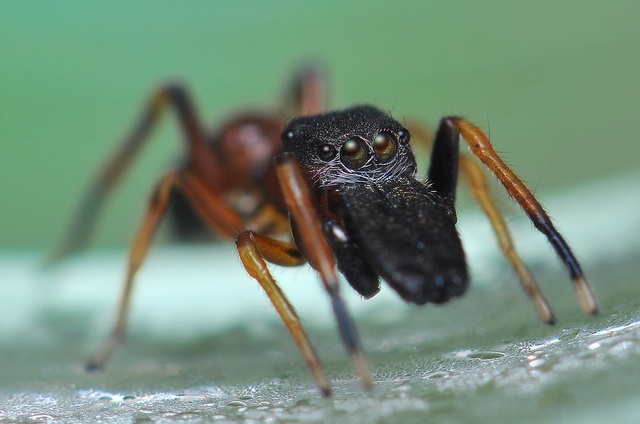Jumping spider cheats predators by walking like an ant
The jumping spider Myrmarachne formicaria successfully imitates the walk of ants, misleading larger spiders that hunt for critters. Predators often refrain from attacking the jumping spider, as much as they are reluctant to attack ants, as Paul Shamble and colleagues observed.
The jumping spider Myrmarachne formicaria, only a few millimetres long, resembles an ant; it is, for instance, pretty thin. This resemblance is functional. Many predators, especially larger spiders and wasps, will readily grasp a small spider, but mostly refrain from attacking an ant, as this prey may bite, spray acid or sting to defend itself and is often assisted by nest-mates. By mimicking an ant, a small spider may protect itself against predators.
Not trivial
But a spider that aims to be mistaken for an ant not only has to look like an ant, but it also has to move like an ant.
That is not trivial, Paul Shamble and colleagues point out. Spiders walk on eight legs and ants on six, and the legs are driven differently. Spiders walk along a pretty straight line, while the path of ants is looped – unless they follow an odour track laid down by their nest-mates; in that case they walk a highly regular zig-zag route along the trail. Jumping spiders, to which Myrmarachne formicaria belongs, hunt while walking; they typically stalk their prey carefully, making long pauses. Ants, on the contrary, move on continuously. When jumping spiders approach a prey, they leap towards it from a distance; ants don’t jump.
A jumping spider thus has to modify its movements significantly to mimic the behaviour of an ant. Is Myrmarachne formicaria able to do that?
Using three high-speed cameras, the researchers filmed Myrmarachne formicaria, non-mimecic jumping spiders and ants walking across a glass surface and analysed their gaits. The analysis revealed that Myrmarachne formicaria imitates the walk of an ant very well. The spider walks on eight legs like other spiders do, but it moves its legs in an ant-like manner. It imitates the zig-zag behaviour of an ant that follows an odour trail. It does make pauses, but only very short ones. When stationary, it raises its forelegs, pretending to be an ant with a pair of antennae and three pairs of legs. The researchers never observed it leaping.
Animations
Finally, based on the video recordings, Shamble produced animations of an ant, a non-mimic jumping spider and Myrmarachne formicaria, presented these animations to a large predatory spider and observed its response. The predator was attracted to all of these targets, but not to the same extent. It attacked a jumping spider target more often than an ant target, and, importantly, it was not more likely to attack an ant mimic than an ant.
So, Myrmarachne formicaria cheats large spiders by imitating the appearance as well as the behaviour of an ant, protecting itself from these predators. It would be interesting to know whether predators with better visual capacities, like shrews, birds, lizards or toads, are also misled by this mimicry.
Willy van Strien
Photo: Jeff Burcher (via Flickr. Creative Commons CC BY-NC-ND 2.0)
Source:
Shamble, P.S., R.R. Hoy, I. Cohen & T. Beatus2, 2017. Walking like an ant: a quantitative and experimental approach to understanding locomotor mimicry in the jumping spider Myrmarachne formicaria. Proc. R. Soc. B 284: 20170308. Doi: 10.1098/rspb.2017.0308
